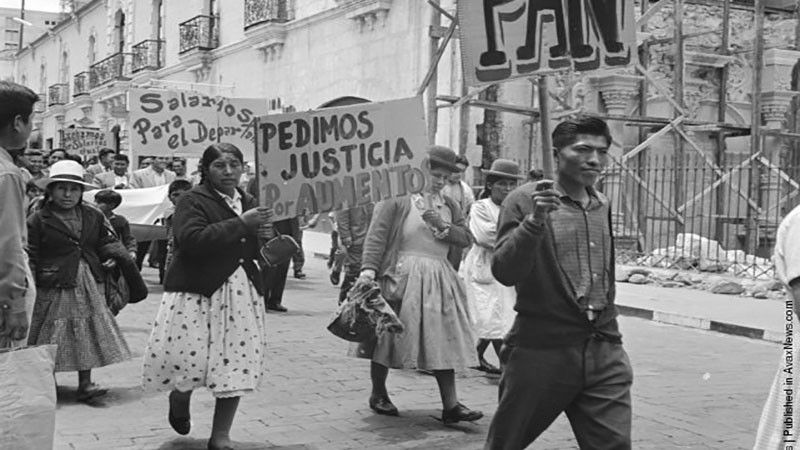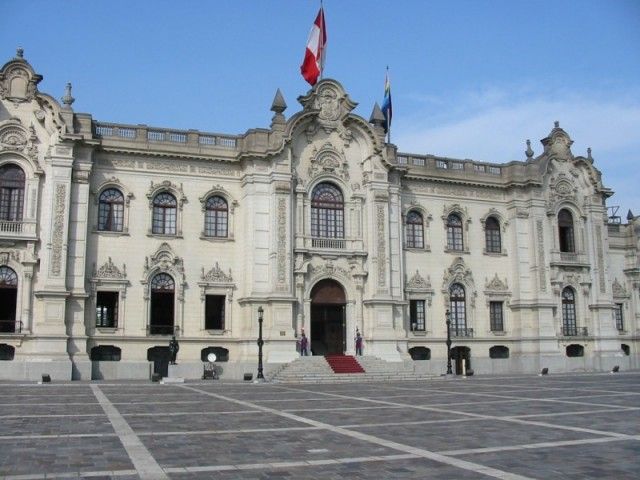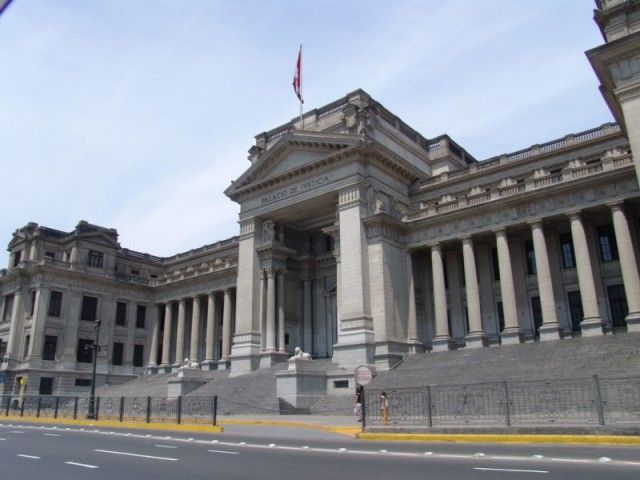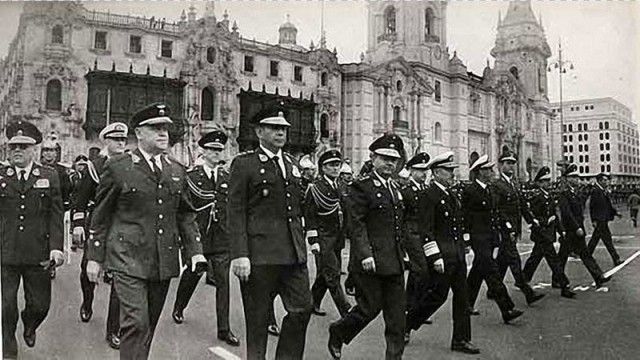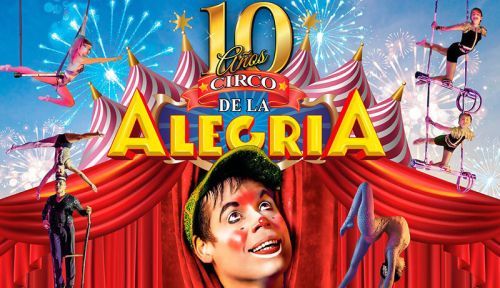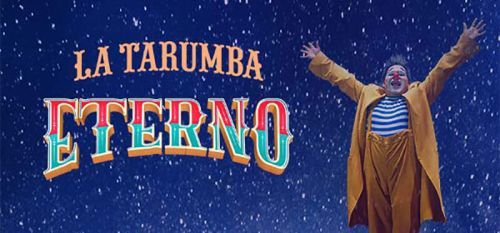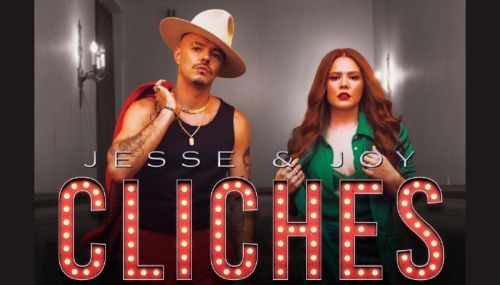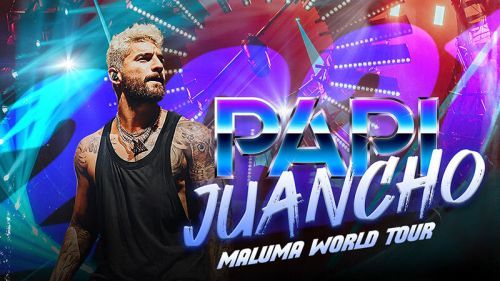After President Augusto B. Leguía settled the Tacna-Arica dispute with Chile in 1929 resulting in the Peruvian loss of Arica and angering extreme nationalists, and with the Great Depression in full swing draining foreign investment from Peru, his eleven-year dictatorship ended with being removed from office in a military coup.
President Luis Miguel Sánchez Cerro (1930 - 1933)
In 1930, a military junta headed by Lieutenant Colonel Luis Miguel Sánchez Cerro overthrew Leguía and another period of political instability and unrest followed. Sánchez Cerro won the presidential elections of 1931. However, APRA, the main opposition party, claimed election fraud and started a campaign to discredit the regime. In July 1932, Apristas carried out an uprising in the city of Trujillo on the northern Peruvian coast, including a bloody takeover of the military garrison. In response, Sánchez ordered the bombing and recapture of the city. In the aftermath tens of thousands of Apristas were executed or imprisoned; this ultimately led to the retaliatory assassination of Sánchez by an Aprista in 1933.
President Oscar Benavides (1933 - 1939)
To avoid chaos, General Oscar Benavides, who already served as Peruvian President from 1914 to 1915 by a coup d’état, was appointed Constitutional President of the Republic.
His mission was to restore the internal and external stability of the country, rebuilding the confidence in the economy. To avoid war, Benavides settled an ongoing border dispute with Colombia by returning the port of Leticia on the Amazon and some territory which gives access to the river, to Colombia as stipulated in a treaty from 1922. Benavides reduced the strength and influence of opposition parties by declaring APRA illegal and repressing the Communist Party, by relentlessly persecuting their leaders, and by implementing social projects. Benavides ruled Peru under the motto “Order, peace and work”. His administration built housing for workers and their families, implemented social security for workers, and brought a new Civil Code on the way. Benavides as well strengthened the military and purchased modern armaments. The Navy Dock and Ship Dry Dock of Callao were built. The Pan-American Highway was completed from Ecuador to Chile along the Peruvian coast, as was the Carretera Central (the Central Highway) crossing the Andes east from Lima to the Amazonian Forest. And the remodeling of the Presidential Palace (Palacio de Gobierno) and the Justice Palace (Palacio de Justicia) were initiated.
President Manuel Prado (1939 - 1945)
With the most important opposition parties banned and critical press shut down, Manuel Prado y Ugarteche, as son of former Peruvian president Mariano Ignacio Prado a member of an aristocratic family of Lima and a member of the Partido Civil who supported General Oscar Benavides in the coup against President Guillermo Billinghurst in 1914, won the presidential election of 1939. Basically, he just continued General Benavides work, but his tactical cleverness, strategic flexibility and personal charm made him one of Peru's most effective politicians of the 20th century. During World War II, Peru first suffered from the huge impact the war had on international trade. However, Prado’s administration managed to counteract sharply fallen imports which were mainly needed for domestic consumption with broadening local production, and was able to increase Peru’s exports (sugar, cotton, petroleum, minerals and metals as well as rubber) bringing economic prosperity. The country cooperated with the US allowing the Allies to use Peruvian airports and ports and even to set up an air base in Talara in northern Peru, shipped German and Japanese immigrants to US confinement camps as part of the Japanese American Internment program and as first country in South America broke off relations with the Axis powers (Germany, Italy and Japan), but still implemented a strict policy of denying visas to Jews trying to escape the Holocaust in Europe.
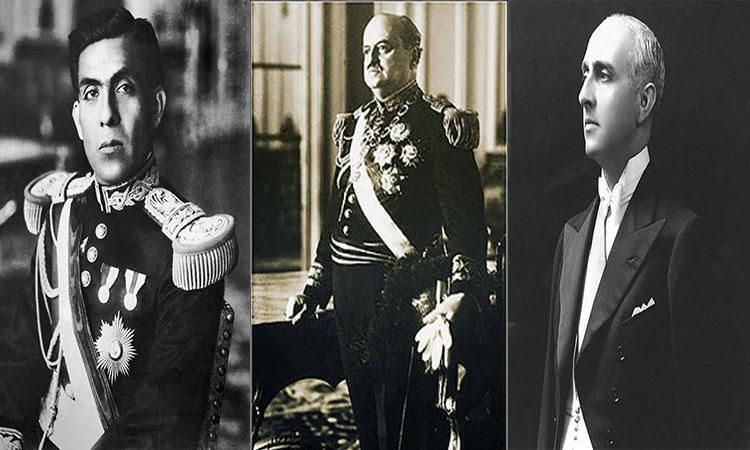
President José Bustamante (1945 - 1948)
The end of World War II not only brought economic well-being (from which unfortunately the poor and mostly indigenous rural population didn’t benefit and thousands decided to flock to Lima in the hope for a better future), but also hope for a real democracy. In 1945, José Luis Bustamante y Rivero, a lawyer and diplomat from Arequipa, won the presidential elections as the candidate of the Frente Democrático Nacional (National Democratic Front), a moderate, left-of-center party representing mostly the middle- and upper-class. To govern, Bustamante needed the support of the APRA, again a legal party, who had obtained the majority of seats in Congress, and the Peruvian Communist Party. Within the first week of his presidency, Bustamante restored civil rights and the freedom of press in Peru and released all political prisoners. Hoping to create a more democratic government, he limited the power of the military and oligarchy. However, the peace didn’t last long. As Bustamante usually followed his own course, conflict with the supporting APRA was inevitable and the Apristas withdrew their support. Now with severely limited options, he dismissed his cabinet and replaced it with a mostly military one. After the 1948 revolt of sailors and officers in Callao (most probably induced by Apristas) was suppressed by government loyal troops, Bustamante had the APRA headquarters occupied, its newspaper, La Tribuna, seized and several prominent Apra members arrested. Peru was back to square one, and the hope for more democracy was crushed.
And the president’s actions in handling the crisis weren’t enough for the right-wing members of his cabinet and especially his Minister of Government and Police, General Manuel A. Odría, a military officer and fierce opponent of APRA.
President Manuel Odría (1948 - 1956)
In October 1948, General Manuel A. Odría led a military coup against President Bustamante and took over as president. His first action was to take extreme measures to suppress the Apristas, and civil rights were severely restricted, pleasing the oligarchy and all others on the right. But thanks to a booming economy - the demand for Peruvian minerals was high and a friendly policy toward foreign capital prompted large-scale investments - he could as well implement expensive social programs increasing his popularity with the poor and lower classes. However, a decline in international trade and the ever-present corruption during his regime drained the treasury.
To the surprise of everyone who feared his authoritarian regime would last forever, in 1956 Odría allowed opposition parties and called for elections.
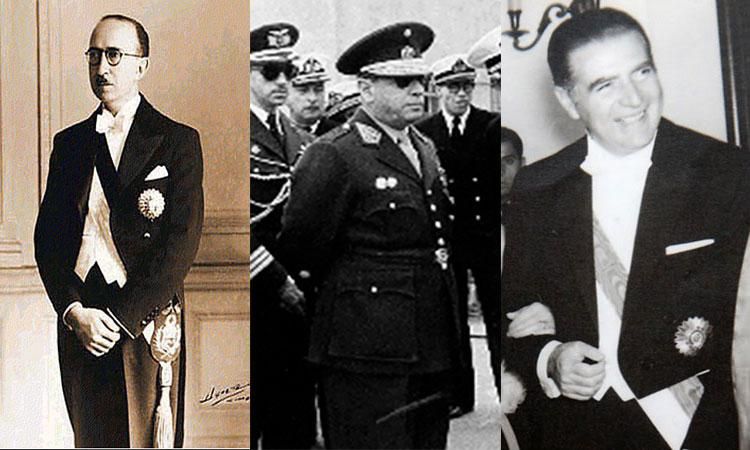
President Manuel Prado (1956 - 1962)
Supported by Odría, Manuel Prado, already President from 1939 to 1945, won his second term. Inheriting an empty treasury from his predecessor, he managed to push Peru’s fishing industry and increased Peru’s GNP significantly. Nevertheless, he didn’t find a solution to improve the terrible situation and living conditions of the rural population, the countless migrants that due to the rural poverty and hopelessness moved to Lima looking for a better future but ended there in the ever-growing slums that surrounded the Peruvian capital, and the underpaid and exploited urban working class.
In the 1962 elections - with popular discontent and political tension at the highest level – none of the candidates managed to receive the constitutionally established minimum of one third of the vote and the selection of the president should have fallen to Congress. However, allegations of electoral fraud and the hostile relationship between military and APRA, whose candidate had the most votes, prompted the military forces to install a junta led by Ricardo Perez Godoy. New elections were held in 1963 which Fernando Belaúnde Terry, a liberal and reformist who offered an alternative to the conservative forces and the left-wing APRA, won.
President Fernando Belaúnde Terry (1963 - 1968)
Fernando Belaúnde promised to tackle the severe social and economic problems of the country by pushing a number of development projects. The Agrarian Act of 1964 was the legal basis to confiscate unused and misused land and distribute it to the rural population. Additionally, the rural population was encouraged to settle on the fertile lands in the foothills east of the Andes. Several local development and irrigation projects in the Peruvian provinces, a housing program for the working class in Lima and other cities, infrastructure development projects (including an expansion of the road and hospital network as well as the implementation of hydroelectric projects), improvements of the social security and in the education sector were supposed to reduce poverty and inequality, improve living conditions and integrate the mostly poor and deprived rural regions. However, some bad economic decision resulted in a devaluation of Peru’s currency in 1967. The settlement of a long-standing dispute over claims to the rich La Brea and Pariñas oil fields with Standard Oil of New Jersey and Peru’s agreement to pay the company a hefty compensation finally caused the barrel to overflow in 1968. Belaúnde was removed from office by a military coup led by General Juan Velasco Alvarado, who would become Peru’s next dictator.


